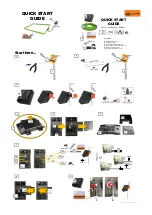
55
Reverse any of CH1, 5, 6, and 7 by moving to the
appropriate channel number with the right or left
keys, then pressing the minus (–) or Plus
(+)
key to reverse or unreverse the
channel. Be sure you get the aileron response in
the picture.
Next, move the elevator stick and be sure that the
elevator moves the correct directions. Reverse
CH 2 if necessary. Similarly check the response
of the rudder (CH4). If you have a V-tail, you
should get the following response for rudder and
elevator commands:
Up elevator command
Left Rudder command
7. Double-check to make sure all the servos
move the correct way! Then, go to the ATV
menu and specify the maximum servo throws
while moving all the controls. Spend some time
getting the correct motions in this step.
8. Move to the flap
→
aileron (FLP
→
AI, p. 60)
menu, and activate by pressing the Plus (+)
key. Use a setting of 100% so the motion
of all four wing servos is the same with flap and
aileron horns that are the same length. If the horn
lengths differ (hopefully in pairs) you can use a
number either greater or less than 100%
depending on the length ratio. The camber
changing is done by turning the leftmost knob on
the top center of the transmitter (CH. 6 flap trim
knob).
9. To set the amount of camber-changing across
the wing, go to the flap trim menu (FLPTRM, p.
39) and activate it by pressing the Plus (+)
key. Set it to a small number (about 5%),
or set it to zero if you want no camber-changing
(this may be changed later for more travel). For
cruising, you'll want no droop at all, but for slow-
speed thermalling, you may want to droop the
trailing edge a bit. Use the flap trim setting to get
the desired amount of camber. No more that
about 1/8" (3 mm) is all that is needed for most
models.
Note that the motion dictated by the Camber knob
(CH. 6 flap trim knob) goes into both positive and
negative camber from the neutral point, unless
you set the F
→
A offset (see previous step). Also,
note that if you don’t set a small number or leave
it inhibited (its default condition), you get HUGE
motion of the trailing edge. You can set the
approximate neutral point by matching the notch
on the front of the knob with the slot in the knob
holder.
10. Put the camber knob (CH. 6 flap trim knob,
on the top left of the transmitter) where you want
it to be for normal flight, and make sure that the
travel you desire is the right direction from that
point. Be sure to center all of the trims, and get
all of the servo arms to be near neutral. Use the
clevises to get as close as you can. This way you
won't run out of subtrim authority. Now set all
the subtrims (SUBTRM, p. 39) to the desired
neutral locations.
You can set the neutrals for the ailerons and flaps
by using the foam wing beds or matching up with
the rest of the wing. Don’t use the fuselage
airfoil (if any) as these are often not aligned
properly. Set the elevator incidence per the
plans/instructions, and center the rudder.
11. Go back to differential (AI-DIF) and set to
get more 'up' throw than 'down' on the ailerons.
For starters, use a down travel of about 50% of the
up travel. Your model may have different plus
and minus signs depending on the servo
orientations. Note that you set the right aileron’s
travel in both directions (move stick to change
flashing display), then go to the left aileron’s
menu and repeat inputting values.
CH 1 (right) aileron:
Right aileron down travel Right aileron up travel
















































